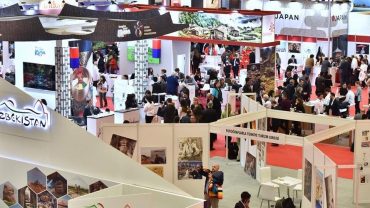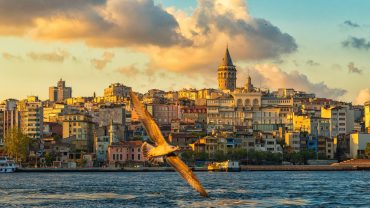
Istanbul, formerly Byzantium and Constantinople, is the largest city in Turkey and the country’s economic, cultural and historic center. The city straddles the Bosporus strait, and lies in both Europe and Asia, with a population of over 15 million residents. Istanbul is the most populous city in Europe, and the world’s fifteenth-largest city. Founded as Byzantion by Megarian colonists in 660 BCE, and renamed as Constantinople in 330 CE, the city grew in size and influence, becoming a beacon of the Silk Road and one of the most important cities in history. It served as an imperial capital for almost sixteen centuries, during the Roman/Byzantine (330–1204), Latin (1204–1261), Byzantine (1261–1453), and Ottoman (1453–1922) empires. It was instrumental in the advancement of Christianity during Roman and Byzantine times, before its transformation to an Islamic stronghold following the Fall of Constantinople in 1453 CE. In 1923, after the Turkish War of Independence, Ankara replaced the city as the capital of the newly formed Republic of Turkey. In 1930 the city’s name was officially changed to Istanbul, an appellation Greek speakers used since the eleventh century to colloquially refer to the city. Over 13.4 million foreign visitors came to Istanbul in 2018, eight years after it was named a European Capital of Culture, making the city the world’s fifth-most popular tourist destination. Istanbul is home to several UNESCO World Heritage Sites, and hosts the headquarters of numerous Turkish companies, accounting for more than thirty percent of the country’s economy. Architecture Istanbul is primarily known for its Byzantine and Ottoman architecture, and despite its development as a Turkish city since 1453, contains both Christian and ancient monuments. There are three ancient monuments in the city. The most ancient is the Egyptian Obelisk. Built of red granite, 31 m (100 ft) high, it came from the Temple of Karnak at Luxor, erected in 1500 BC. It was brought to Istanbul in 357 CE by the order of Constantine II and put up in the Hippodrome. When re-erected, the Egyptian Obelisk was mounted on a decorative base, with a statue that depicted Theodosius I and his courtiers. Next in age is the Serpentine Column, from 479 BCE. It was brought from Delphi in the time of Augustus and also erected in the Hippodrome. The slightly smaller Column of Constantine Porphyrogenitus, was another of Augustus’s trophies. Built of porphyry, 35 m (115 ft) high, it came from Heliopolis, erected in 330 CE to inaugurate the new Byzantine capital. Originally part of a sculpture of Emperor Constantine the Great dressed as Apollo, the column first stood at the entrance to the Forum of Constantine. There are traces of the Byzantine era throughout the city, from ancient churches that were built over early Christian meeting places like Chora Church, Hagia Irene to public places like the Hippodrome, the Augustaion. It is the Hagia Sophia, however, that fully conveys the period of Constantinople as a city without parallel in Christendom. Hagia Sophia, topped by a dome 31 meters (102 ft) in diameter over a square space defined by four arches, is the pinnacle of the Byzantine architecture. Hagia Sophia stood as the world’s largest cathedral in the world until it was converted into a mosque in the 15th century. The minarets date from that period. Over the next four centuries, the Ottomans transformed of Istanbul’s urban landscape with a vast building scheme building towering mosques and ornate palaces. Blue Mosque, another landmark of the city, faces Haghia Sophia in Sultanahmet Square. Among the oldest surviving examples of Ottoman architecture in Istanbul are the Anadoluhisarı and Rumelihisarı fortresses, which assisted the Ottomans during their siege of the city. Over the next four centuries, the Ottomans made an indelible impression on the skyline of Istanbul, building towering mosques and ornate palaces. Topkapı Palace, dating back to 1465, is the oldest seat of government surviving in Istanbul. Mehmet II built the original palace as his main residence and the seat of government. The present palace grew over the centuries as a series of additions enfolding four courtyards and blending neoclassical, rococo, and baroque architectural forms. In 1639 Murat IV made some of the most lavish additions, including the Baghdad Kiosk, to commemorate his conquest of Baghdad the previous year. Government meetings took place here until 1786, when the seat of government was moved to the Sublime Porte. After several hundred years of royal residence, it was abandoned in 1853 in favor of the baroque Dolmabahçe Palace. Topkapı Palace became public property following the abolition of monarchy in 1922. After extensive renovation, it became one of Turkey’s first national museums in 1924. The imperial mosques include Fatih Mosque, Bayezid Mosque, Yavuz Selim Mosque, Süleymaniye Mosque, Sultan Ahmed Mosque (the Blue Mosque), and Yeni Mosque, all of which were built at the peak of the Ottoman Empire, in the 16th and 17th centuries. In the following centuries, and especially after the Tanzimat reforms, Ottoman architecture was supplanted by European styles. An example of which is the imperial Nuruosmaniye Mosque. Areas around İstiklal Avenue were filled with grand European embassies and rows of buildings in Neoclassical, Renaissance Revival and Art Nouveau styles, which went on to influence the architecture of a variety of structures in Beyoğlu—including churches, stores, and theaters—and official buildings such as Dolmabahçe Palace.
Transportation
Istanbul’s motorways network are the O-1, O-2, O-3, O-4 and O-7. By the end of 2019, the total length of Istanbul Province’s toll motorways network (otoyollar) is 513 km and highways network (devlet yollari) is 327 km, totaling 840 km of expressway roads (minimum 2×2 lanes), excluding secondary roads and urban streets. The density of expressway network is 15.7 km/100 km2 (2019). The O-1 forms the city’s inner ring road, traversing the 15 July Martyrs (First Bosphorus) Bridge, and the O-2 is the city’s outer ring road, crossing the Fatih Sultan Mehmet (Second Bosphorus) Bridge. The O-2 continues west to Edirne and the O-4 continues east to Ankara. The O-2, O-3, and O-4 are part of European route E80 (the Trans-European Motorway) between Portugal and the Iran–Turkey border. In 2011, the first and second bridges on the Bosphorus carried 400,000 vehicles each day. The O-7 or Kuzey Marmara Otoyolu, is a motorway that bypass Istanbul to the north. The O-7 motorway from Kinali Gişeleri to Istanbul Park Service has 139 km, with 8 lanes (4×4). The completed section of highway crosses the Bosphorus Strait via the Yavuz Sultan Selim (Third Bosphorus) Bridge, entered service on 26 August 2016. The O-7 motorway connects Istanbul Atatürk Airport with Istanbul Airport. Environmentalist groups worry that the third bridge will endanger the remaining green areas to the north of Istanbul. Apart from the three Bosphorus Bridges, the dual-deck, 14.6-kilometer (9.1 mi) Eurasia Tunnel (which entered service on 20 December 2016) under the Bosphorus strait also provides road crossings for motor vehicles between the Asian and European sides of Turkey. Istanbul’s local public transportation system is a network of commuter trains, trams, funiculars, metro lines, buses, bus rapid transit, and ferries. Fares across modes are integrated, using the contactless Istanbulkart, introduced in 2009, or the older Akbil electronic ticket device. Trams in Istanbul date back to 1872, when they were horse-drawn, but even the first electrified trams were decommissioned in the 1960s. Operated by Istanbul Electricity, Tramway, and Tunnel General Management (İETT), trams slowly returned to the city in the 1990s with the introduction of a nostalgic route and a faster modern tram line, which now carries 265,000 passengers each day. The Tünel opened in 1875 as the world’s second-oldest subterranean rail line (after London’s Metropolitan Railway). It still carries passengers between Karaköy and İstiklal Avenue along a steep 573-meter (1,880 ft) track; a more modern funicular between Taksim Square and Kabataş began running in 2006. The Istanbul Metro comprises five lines (the M1, M2, M3 and M6 on the European side, and the M4 and M5 on the Asian side) with several other lines (the M7, M8, M9 and M11) and extensions under construction. The two sides of Istanbul’s metro are connected under the Bosphorus by the Marmaray tunnel, inaugurated in 2013 as the first rail connection between Thrace and Anatolia, having 13.5 km length. The Marmaray tunnel together with the suburban railways lines along the Sea of Marmara, is part of intercontinental commuter rail line in Istanbul, from Halkalı on the European side to Gebze on the Asian side. Marmaray rail line has 76.6 km, and the full line opened on 12 March 2019. Until then, buses provide transportation within and between the two-halves of the city, accommodating 2.2 million passenger trips each day.
The Metrobus, a form of bus rapid transit, crosses the Bosphorus Bridge, with dedicated lanes leading to its termini. İDO (Istanbul Seabuses) runs a combination of all-passenger ferries and car-and-passenger ferries to ports on both sides of the Bosphorus, as far north as the Black Sea. With additional destinations around the Sea of Marmara, İDO runs the largest municipal ferry operation in the world. The city’s main cruise ship terminal is the Port of Istanbul in Karaköy, with a capacity of 10,000 passengers per hour. Most visitors enter Istanbul by air, but about half a million foreign tourists enter the city by sea each year. International rail service from Istanbul launched in 1889, with a line between Bucharest and Istanbul’s Sirkeci Terminal, which ultimately became famous as the eastern terminus of the Orient Express from Paris.
Regular service to Bucharest and Thessaloniki continued until the early 2010s, when the former was interrupted for Marmaray construction and the latter was halted due to economic problems in Greece. After Istanbul’s Haydarpaşa Terminal opened in 1908, it served as the western terminus of the Baghdad Railway and an extension of the Hejaz Railway; today, neither service is offered directly from Istanbul. Service to Ankara and other points across Turkey is normally offered by Turkish State Railways, but the construction of Marmaray and the Ankara-Istanbul high-speed line forced the station to close in 2012.
New stations to replace both the Haydarpaşa and Sirkeci terminals, and connect the city’s disjointed railway networks, are expected to open upon completion of the Marmaray project; until then, Istanbul is without intercity rail service. Private bus companies operate instead. Istanbul’s main bus station is the largest in Europe, with a daily capacity of 15,000 buses and 600,000 passengers, serving destinations as distant as Frankfurt. Istanbul had three large international airports, two of which are currently in active service for commercial passenger flights. The largest is the new Istanbul Airport, opened in 2018 in the Arnavutköy district to the northwest of the city center, on the European side, near the Black Sea coast. All scheduled commercial passenger flights were transferred from Istanbul Atatürk Airport to Istanbul Airport on April 6, 2019, following the closure of Istanbul Atatürk Airport for scheduled passenger flights. The IATA airport code IST was also transferred to the new airport. Once all phases are completed in 2025, the airport will be able to accommodate 200 million passengers a year.
Museums
Museums in Istanbul
- Hagia Sophia
- Hagia Irene
- Chora Church
- Istanbul Archaeology Museums
- Great Palace Mosaic Museum
- Turkish and Islamic Arts Museum
- Istanbul Naval Museum
- Istanbul Modern
- Yıldız Palace
- The Museum of Innocence
- Sakıp Sabancı Museum
- Sadberk Hanım Museum
- Rahmi M. Koç Museum
- Rezan Has Museum
- Istanbul Military Museum
- SALT (institution)
- Pera Museum
- SantralIstanbul
- Miniatürk
- Jewish Museum of Turkey
- Tiled Kiosk
- İstanbul Toy Museum
- Istanbul Postal Museum
- Adam Mickiewicz Museum, Istanbul
- Galatasaray Museum
- Istanbul Railway Museum
- Doğançay Museum
- Aşiyan Museum
- Istanbul Aviation Museum
- Museum of Illumination and Heating Appliances
- Florya Atatürk Marine Mansion





Comment (0)